Nike Missile Base W-25, Maryland
In April 1953, Nike-Ajax sites were given top priority in the Army military construction budget, with the objective of having battery sites in the Washington-Baltimore, New York, Chicago and Detroit Defenses ready for occupancy by December 1, 1953. Number one on the priority list was the 36th AAA Missile Battalion, Washington-Baltimore Defense. Since delays in acquiring private property were expected, initial emphasis was placed on sites on government-owned land. The battalion took up its temporary positions at Fort Meade on schedule, but encountered serious delays in moving to permanent sites, originally planned for October 1954.
Selection of suitable battery sites, and acquisitions of land parcels thus identified, proved "major obstacles to the expeditious deployment of Nike units throughout the United States." Where possible, public lands were chosen, even though optimum defense and tactical considerations might dictate otherwise. But there was insufficient public land in the defended areas, and extensive compromise would obviously prove detrimental to the air defense program.
"By far the greatest number of battery sites had to be located on privately-owned land, and in most instances, high real estate costs and adverse reaction by owners made the acquisition problems acute. Very specific and restrictive standards had to be applied to the location. The general public, not knowing the necessity for interrelationship and topographic configuration of Control and Launcher Areas to assure both an effective defense ring and the proper functioning of the weapon system within the battery, often thought that site selections were made either arbitrarily or capriciously and, while almost everybody favored Nike, almost nobody wanted a unit located next door."
To partially ease public opposition, the Army Chief of Staff decided in late October 1953 that underground missile storage magazines would be installed at all sites, rather than relying on above-ground dispersal, as originally contemplated in project drawings. This change, coupled with an improved public relations campaign, did ease public acceptance, especially in more congested urban areas. But it also imposed a four-month delay on the program, because of developments in the Hercules project. Ajax magazines and elevators were too small to accommodate the larger Hercules, so new structures had to be designed. Since Hercules itself was in the developmental stage, any redesign was necessarily tentative. Site selections also had to be reviewed against preliminary revised criteria, released November 20, 1953. Final drawings were not issued until late January 1954. To speed up construction, the Chief of Staff specified in February 1954 that most batteries would consist of two Ajax and one Hercules magazine. By this time, however, the Ajax magazines themselves were being redesigned. To prevent further delays, 60 launcher sites, including W-25, were designed to consist of two magazines, both "universal" (capable of handling both Ajax and Hercules).
Site W-25 was caught up in these delays. Originally intended for Kent Island, W-25 was switched to Davidsonville in April 1954 "due to technical deficiencies and high real estate costs. . . ." Twenty-five acres for a launcher area had been purchased outright in August 1952, as part of the overall Defense site acquisition plan (exact site designations were subject to change as the program matured). Purchase of 16 acres for the battery control area was thornier, and condemnation proceedings were invoked. The U.S. District Court for Maryland awarded a declaration of taking two years after the launcher area had been purchased. Legal action was also necessary to obtain an additional ten acres some 500 yards down Wayson Road, where the collimation tower (for testing electrical axes of radar antennae) was to be installed. The District Court award came in May 1955.(28) Finally, land for housing the families of married soldiers had to be purchased, since adequate "community support" (private housing for rent) was not available in the Davidsonville area. The housing site had to be as close to the battery as possible to minimize delay in recalling off-duty troops. Eight acres on the north side of Queen Anne Bridge Road, directly across from the eastern end of the control area compound, were chosen. Following a third condemnation proceeding, the land was purchased in July 1958. It was immediately leased to Davidsonville Homes, Inc., for a term of 55 years, for construction of a 16-unit Armed Forces Housing Project.
Thus, nearly 60 acres were acquired to fully develop the Davidsonville site. Extracting acreage for family housing, Site W-25 closely approximated the average for similar Nike installations.
"The ground control guidance equipment is located in a plot of 6 to 8 acres - the Control Area - which includes, basically, three radars and a computer. The first, an acquisition or search radar, detects the approach of distant aircraft. Once a target is selected, a second or tracking radar picks it up and feeds data regarding its location and movement into the computer. The third radar, the missile tracking radar, follows the missile throughout its flight, reporting its movement to the computer. The computer instantaneously and continuously thereafter calculates the closest point of intercept between the missile and target and directs the missile toward the target.
A Launcher Area is located 1 to 4 miles away from the Control Area. It consists of approximately 42 acres, of which 15 are required for the operating facilities and the remainder as a surrounding safety zone. The principal elements contained within the Launcher Area are: underground storage magazines, launchers, missile assembly building, fueling area, control van, generators, administration and housing facilities, and appurtenant utilities. Troop housing is generally located at either the Launcher or Control Area but in some cases may be divided between the two areas."
Bids for construction of Site W-25 were solicited in April 1954, but poor contractor performance and difficulties with elevator installation and repair delayed completion. The April 1955 revised overall deployment plan called for W-25's tactical facilities to be completed for occupancy in May, and troop housing in June, of that year. The tactical facilities were completed on schedule, and the first occupant--Battery B-36th AAA Missile Battalion--moved to its permanent site June 10, 1955.
The standard Ajax battery table of organization and equipment (TOE) published in May 1955 called for 106 officers, warrant officers and enlisted men. This was increased to 113 men in the revised TOE (November 1957), and to 115 in August 1960, the last major TOE revision (Table 2).32 With only two underground magazines, Battery B (Site W-25) was modified by having two Launching Sections, rather than three.
A configuration of main and satellite launchers was used to attain maximum fire-power from each battery's "basic load" of missiles. During an alert, the three above-ground satellite launchers were loaded via an elevator from the underground magazine, where missiles were assembled and armed, and erected to the firing position of 89°. A fourth Ajax would then be brought to the surface on the elevator, which doubled as a launching rail. This configuration permitted a total of four missiles per Launching Section to be readied for firing. At BATTLE STATIONS alert status, a missile could be launched within 30 seconds of the order.
"During a fire mission the missile on the elevator-launcher of one launching section is fired, followed by the missile[s] on the elevator-launcher[s] of the [second and third sections]. Using this sequence each section can reload the elevator-launcher while the other two sections are firing, and consequently maintain the maximum rate of fire. This procedure is followed as long as missiles are available in the underground [magazines]. When these have been exhausted, the three missiles located on satellite launchers at each section are fired as desired by the [battery] commander."
When launched, the missile's four booster rockets accelerated Ajax to supersonic speed, burned out in a few seconds, then separated and fell into a predetermined "booster disposal area." After separation, the Ajax's liquid fuel sustainer rocket ignited, maintaining supersonic speed to target intercept. The target and missile tracking radars constantly fed data to the fire control computer, which in turn transmitted in-flight correction signals to the missile. Antennae on the missile received these signals and directed them to the steering fins which maneuvered the missile into lethal proximity to an intruder aircraft. Evasive action was immediately detected and course correction signals transmitted from the control area. "This action continue[d] until the missile and the target [were] within a fraction of a second of physically colliding. The computer then [sent] a burst command to the missile, detonating the warhead containing thousands of steel fragments which engulf and destroy the target."
Original engineer plans called for a mobile, "primitive encampment" site environment, with prefabricated shelters, gravel-surfaced sidewalks and roads, and scant concern for overall appearance. Public opposition to the eyesore presented by early Nike sites, coupled with considerations of troop morale and equipment maintenance needs, prompted a change to permanent fixed installations. Thus evolved the "mini-post" appearance associated with Nike sites: paved roads and walkways, conventional buildings painted in colors compatible with those of local communities, and grass, trees and flowers providing screen and shade cover. Unit morale, strained by "long, tiresome hours of troop duty" frequently in isolated areas, was boosted by constructing "good living quarters and mess halls, day rooms, hobby shops, post exchanges, and athletic facilities."
Site W-25 saw several major changes during 1958. Battery B-36th AAA Missile Battalion was reorganized for Hercules June 20. Conversion construction, including installation of an intrusion detection system, was completed July 2, making W-25 the third operational Hercules site in the Continental United States. On September 1, the 36th came under CARS and was redesignated 1st-562d Artillery. Battery B retained its alphabetical designation. W-25 held an "open house" three days later to celebrate these changes.
Because W-25 already had "universal" magazines, conversion from Ajax to Hercules involved only minor additional construction; site configuration remained substantially the same. Reliance on existing Ajax sites was necessitated by the huge costs of constructing Hercules-specific sites. At best, this compromise was less than satisfactory to ARADCOM officials, because "a weapon with an 85 mile range [was] sited at locations selected . . . for a 25-mile range missile." Worse still, failure to relocate Hercules batteries meant greater vulnerability to nuclear attack, since they were kept needlessly close to primary target areas. A measure of protection was provided by constructing reinforced concrete buildings with filtered ventilation systems to reduce damage, casualties and contamination from blast over-pressure and fallout. Fallout protection construction at W-25 was completed in December 1964. Troops were equipped with special clothing for nuclear-biological-chemical warfare protection. Missile Masters were also centrally located in the defense area, and thus highly vulnerable. Further, since Hercules conversion meant there would be fewer firing batteries for the AADCP to coordinate, Missile Master carried the added onus of being "overcapable," especially in relation to maintenance and personnel costs. This was addressed by gradual substitution of smaller fire distribution systems. These were colocated with firing batteries, outside of the immediate target area, increasing survivability. For example, Missile Mentor, capable of controlling up to 16 batteries, replaced Missile Master at Fort Meade in August 1966.
Battery B proved equal to the Hercules challenge. In 1962, under Capt. Myron W. Rose, the battery was the first recipient of the Robert W. Berry Award, given annually to ARADCOM's outstanding missile site.(39) On December 11, 1962, the same day A-1st-70th took control of the Annapolis-Bay Bridge site, 1st-562 was inactivated. Simultaneously Battery B-1st-71st Artillery took over W-25. Sometime in 1963 or 1964, Battery B was attached to 4th-1st Artillery for administrative and operational control, and subsequently redesignated B-4th-1st Artillery. Fourth-1st Artillery thereafter constituted the Regular Army component of the Washington-Baltimore Defense, and was deployed as follows: HHB and Battery C--Edgewood Arsenal, Battery A--Rockville, Battery B--Davidsonville, and Battery D--Tolchester (on Maryland's Eastern Shore).
On August 30, 1963, Davidsonville was honored by being named the "National Nike Site." This designation imposed an additional mission of serving as a "show-case" Hercules installation for visiting national and foreign dignitaries and organizations. From 1957 through 1963, this mission had been assigned to Lorton, Virginia (Site W-64). Lorton had been a "dual site," part Hercules (Regular Army) and part Ajax (National Guard). When the Ajax missiles were removed, the Regulars pulled out, leaving Virginia's A-1st-280th Artillery (later A-4th-111th Artillery) as sole occupant.
Davidsonville's fame was furthered in May 1964, when Battery B took ARADCOM's Distinguished Firing Battery Award. This honor was bestowed in recognition of the unit's outstanding performance in annual service practice (ASP) firing competition. ASP, also called short notice annual practice, had been initiated in July 1961 to provide a reasonable test of battery proficiency. It will be recalled that Guard gun batteries could, for safety reasons, fire only at the Fort Miles range. Similarly, missile batteries could not practice live firing from their sites. This constraint was overcome by requiring each ARADCOM firing battery to travel to the McGregor Range at Fort Bliss, on only 48-hour notice. Once on-range, the units had to set up equipment, draw, assemble, emplace and fire assigned missiles within one week. All on-site batteries fired at least once annually, and ten percent would have to fire a second time during the fiscal year. Batteries were selected at random, so battery commanders never knew when their turn would come, and last minute "cramming" was not feasible. Units therefore had to maintain a high state of readiness at all times. Competition for annual high score was intense, and ARADCOM expressed pleasure at the overall results. ASP was discontinued only upon announcement of ARADCOM's inactivation.
In addition to ASP, firing units were tested on-site through scheduled and no-notice BLAZING SKIES alerts. These came as often as once a week. Any aircraft entering a defense might be designated an intruder, and firing drill completed short of actual launch. Air Force Strategic Air Command (SAC) and Aerospace Defense Command (ADC) periodically provided "faker" aircraft, simulating intruders for battery training under intense electronic warfare conditions. SAC combat crews benefited by being scored on target run and evasion techniques. Nationwide SKY SHIELD and regional training exercises were also held. When aircraft were not available, simulators were used to project electronic "targets."
Ajax and Hercules batteries were basically similar in both configuration and organization, as a comparison of Tables 2 and 3 will reveal. With a total of 134 men, the 1967 standard Hercules TOE most notably lacked Fire Fighting and Fire Unit Integration Facility sections. This resulted from increased safety due to absence of volatile liquid fuel, and advanced electronic capability of the Hercules. A Security Section was added for Hercules because of the presence of nuclear warheads, which imposed stricter security standards. Nuclear storage areas were isolated from the rest of the battery and fenced off. Beginning in June 1958, Military Police sentry dog teams were assigned to Hercules batteries, with four handler/dog teams per Security Section. Nike site duty was found, however, to unduly restrict the career advancement of Military Policemen, so handler slots were later converted for missile crewmen.
Hercules batteries were initially allotted a basic load of 12 missiles, raised to 18 in 1964. However, limited on-site storage capacity meant some of the additional missiles had to be stored at Army depots. Further, not all of the added increment carried nuclear warheads. When sites had the required storage, a limited number of Hercules with high-explosive warheads were stocked "as an added measure of defense against a Soviet U-2 type incursion . . . ."
Maryland's A-1st-70th Artillery had been reduced from 138 men to 126 while manning Hercules at Site W-26. This was accomplished by eliminating one Launching Section, leaving two in the platoon. Upon displacing B-4th-1st Artillery at Davidsonville in November 1968, the Guard battery's authorized strength was cut further, to 124 men (including 33 Mobilization Designee slots). This reduction was permitted because a high power acquisition radar (HIPAR) had been installed at Site W-25 in October 1962. HIPAR, like the alternate battery acquisition radar (ABAR) which the unit had operated at Annapolis, enhanced battery efficiency by gaining more time for decision-making and weapon selection before engagement. Standard Hercules radars acquired targets at a maximum range of 125 nautical miles and transferred to target tracking radars at 100 nautical miles. Missiles could be launched at 98 nautical miles and intercept at 70 nautical miles. Against an intruder flying at March 1 at 11 miles altitude, elapsed time from acquisition to intercept was 305 seconds. By extending acquisition range to 175 nautical miles, HIPAR allowed more than 400 seconds from acquisition to intercept. In a supersonic, computer-paced electronic warfare environment, these added seconds eased the battery commander's task. HIPAR and associated control equipment could also be modified to provide a limited defense against submarine-launched ballistic missiles, increasingly prevalent in the Soviet offensive inventory. To accommodate HIPAR, two of Battery A's augmentation sections (including ABAR), totaling 11 men, were eliminated and a 9-man HIPAR Section added.
A small Regular Army contingent remained at Davidsonville after A-1st-70th Artillery took over. This was the nuclear custodial team, which controlled release of nuclear warheads for fitting to Hercules. Under the Atomic Energy Act of 1954, National Guard air defense units were denied custody of nuclear weapons prior to federalization. Nuclear warheads were delivered to Hercules sites either by helicopter or on tractor-trailers under heavy Military Police escort. While Guardsmen had periodically rebuilt conventional high-explosive warheads, the nuclear variety had to be shipped to the Army ordnance depot at Redstone Arsenal, Alabama, for maintenance. Actual use of nuclear warheads in a combat situation was controlled by AADCP orders, using classified "Weapon Control Case" terminology.
Battery A came to Davidsonville with freshly won honors. In 1968, Captain Thompson's unit garnered three proficiency awards: 35th Artillery Brigade Certificate of Operational Readiness, 1st-70th Artillery's Carl W. Schmidt Honor Battery Trophy, and the battalion's Col. Norman A. P. Miller Operational Readiness Trophy. Battery A's guidon was decorated with an ARADCOM "E" streamer for combat proficiency excellence in 1971. That same year, the unit attained an outstanding score during a command maintenance management inspection. Two years later, under Capt. Donald S. Bowes, Battery A won a second "E" streamer, and scored 98.3 percent in ASP competition.
Davidsonville's solid reputation was thus thoroughly intact when word came to initiate stand-down procedures. Missile components and fire control equipment were shipped to various Army depots to be reconditioned and issued to United States and allied forces still operational with Hercules. Regulars received new duty station orders. Guardsmen were either reassigned to other Maryland units or to those of other states, or separated. Sentry dogs were shipped to Lackland Air Force Base, Texas, for retraining. Army helicopters from the 101st Airborne Division at Fort Campbell, Kentucky, were detailed to assist in moving Davidsonville's packaged equipment. The Army terminated Maryland's permit to occupy site W-25, and held the land pending disposition by the General Services Administration.
On September 17, 1975, the launcher area (24 acres, 15 buildings) was conveyed from Army to the Department of Health, Education and Welfare (HEW) for use as an educational facility. HEW's regional director signed a quitclaim deed January 19, and Anne Arundel County's acting executive accepted the property February 23. The property was formally acquired march 4, 1976, as a county police academy. The control area (16 acres, 13 buildings) was conveyed to the Department of Interior April 15, 1976, for use as a recreational area. Interior's regional director signed a quit-claim deed June 24, and the property was accepted by the county executive six days later, with formal acquisition coming July 7. An additional 33 acres of easements were transferred to GSA and placed in inactive inventory October 27, 1976. GSA closed its books on the former Nike site November 16, 1977.
The family housing area across Queen Anne Bridge Road had been surplus to ARADCOM needs since Guardsmen took over Site W-25. Air Force personnel assigned to the transmitter station just off Route 424 occupied the units after Army families vacated. The Army later planned to dispose of this property, which would have caused eviction of the Air Force families. But the Air Force decided to acquire and renovate the housing units in December 1973, and evictions were averted. Formal transfer came October 30, 1974. The family housing area is the only portion of the original Nike site still in use by a military service.
As of this writing, the old collimation test site is still listed as a property of the "Nike Base, U.S. Army" in county land records, and is still undeveloped.(52) To the casual passer-by, it looks like just another empty field, of no particular significance
How quickly we forget.
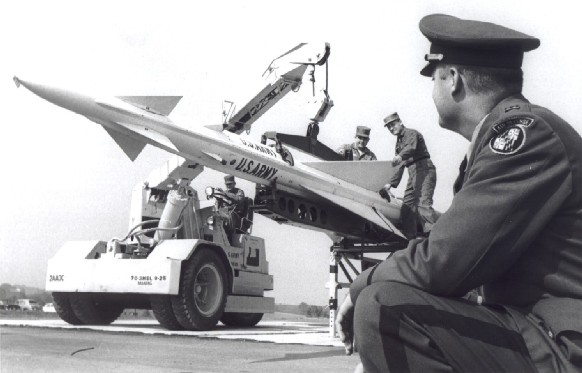
Publicity photo of 3d-70th Artillery personnel with Nike-Ajax, 1960. Note Maryland National Guard shoulder sleeve insignia and "Air Defense" tab on uniform of warrant officer kneeling in the foreground. (NARA photo 111-SC-576509)
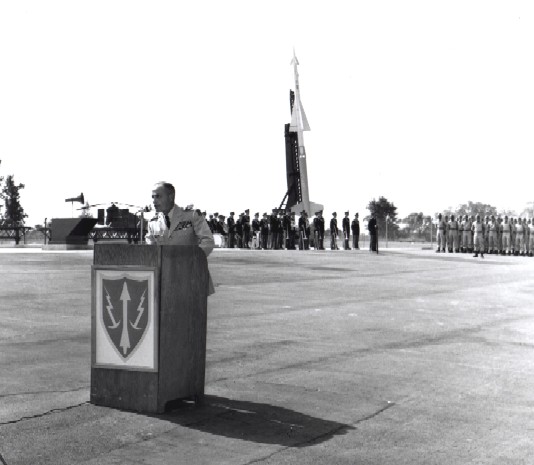
Ceremony marking activation of the first operational Nike-Hercules unit on the east coast at W-25 on Sept. 4, 1958. The firing unit is Battery B-1st Missile Battalion-562d Artillery. In the top photo, Army Vice Chief of Staff Lyman L. Lemnitzer delivers remarks at podium blazoned with ARADCOM insignia--yellow missile and lighting bolts on a red shield trimmed yellow. Note Nike-Ajax on launcher behind band in the background.
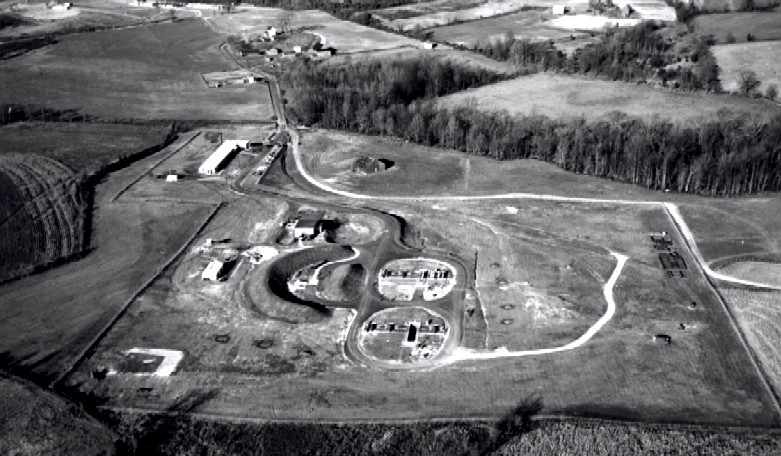
Aerial view of W-25 launch area, Dec. 5, 1956. (NARA photo 111-SC-549340)
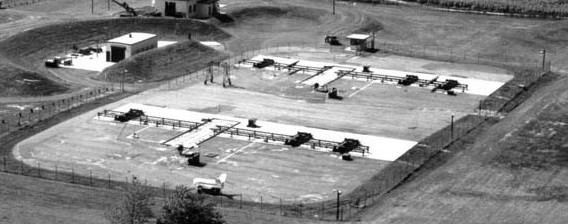
This closeup of the launcher area shows elevators on which missiles were raised from underground storage magazines for firing.
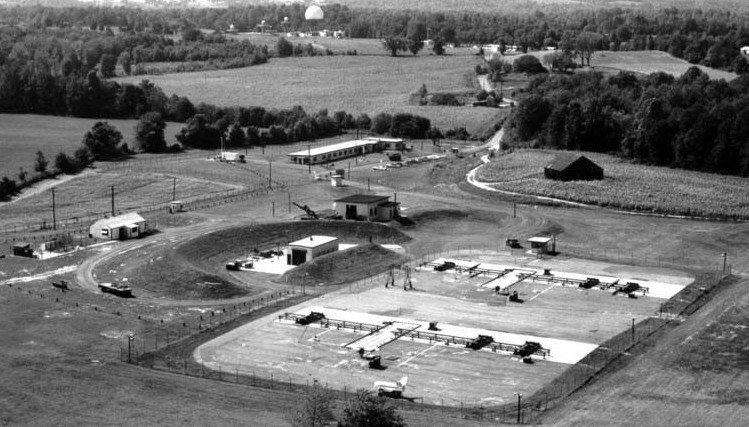
Looking almost due west across the launcher area (foreground) to the integrated fire control (IFC) area (center background) in 1964. The launcher area serves as the Anne Arundel County Police Academy, while the IFC area is the Davidsonville Family Recreation Center.
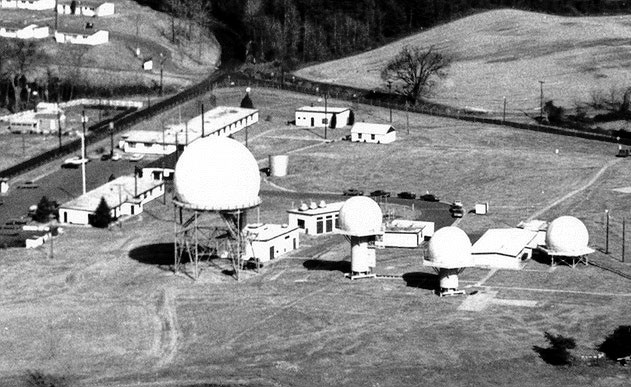
Looking northeast across the IFC area in 1972. Military family housing is at top left, with Queen Anne Bridge Road and Wayson Road intersecting in front. The road joining Wayson Road at top center is Elmer F. Hagner Lane, which leads to the launcher area,
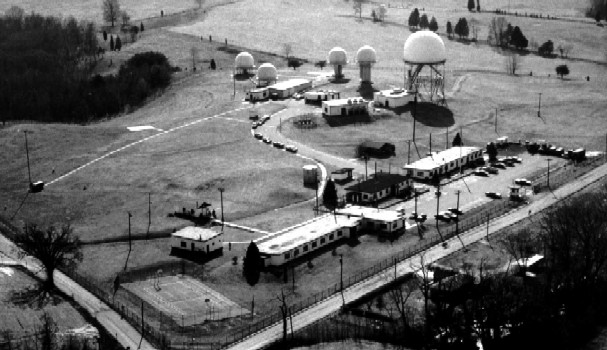
This 1972 view looks south across the IFC area, with Queen Anne Bridge Road at lower right.